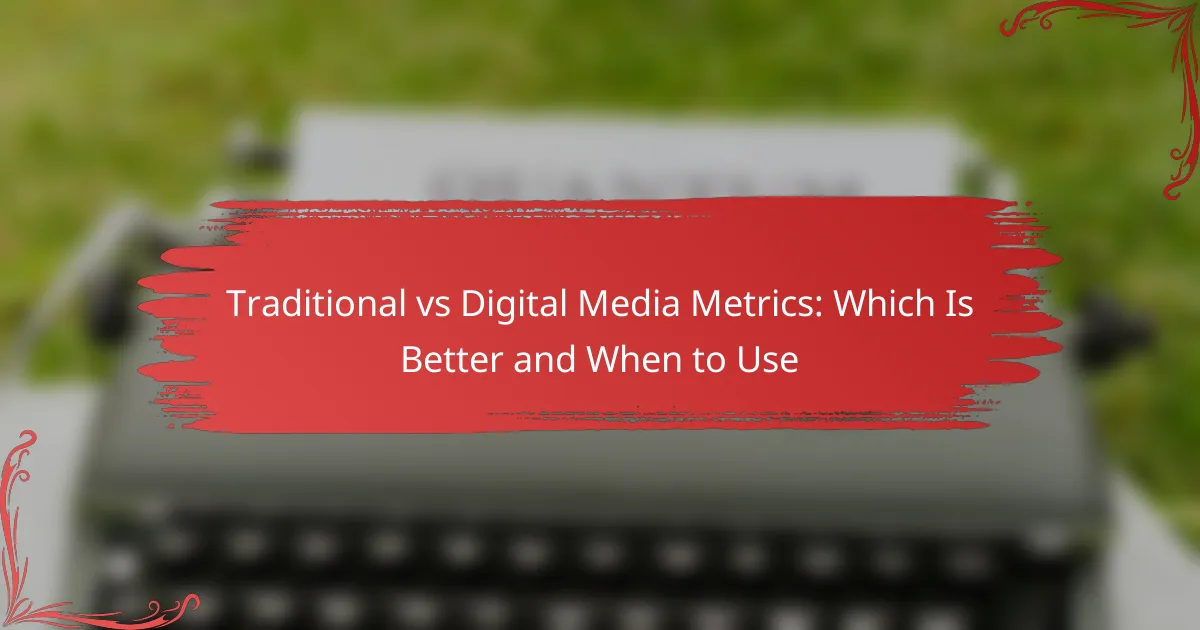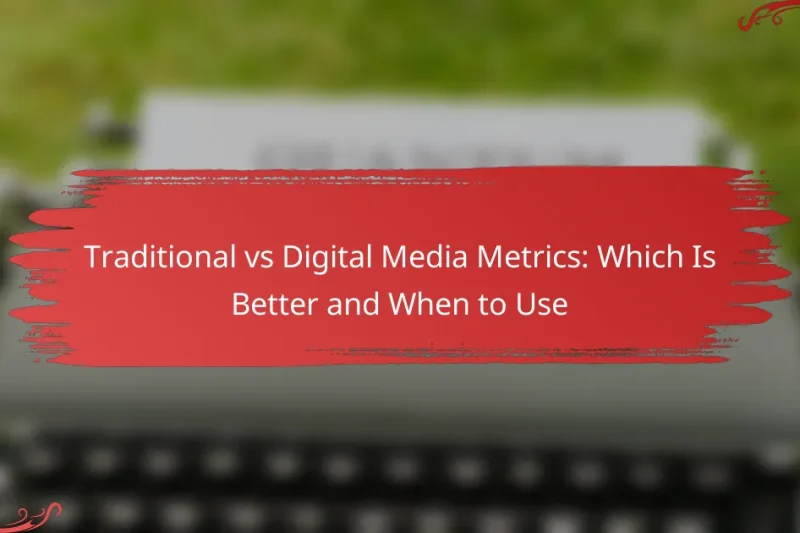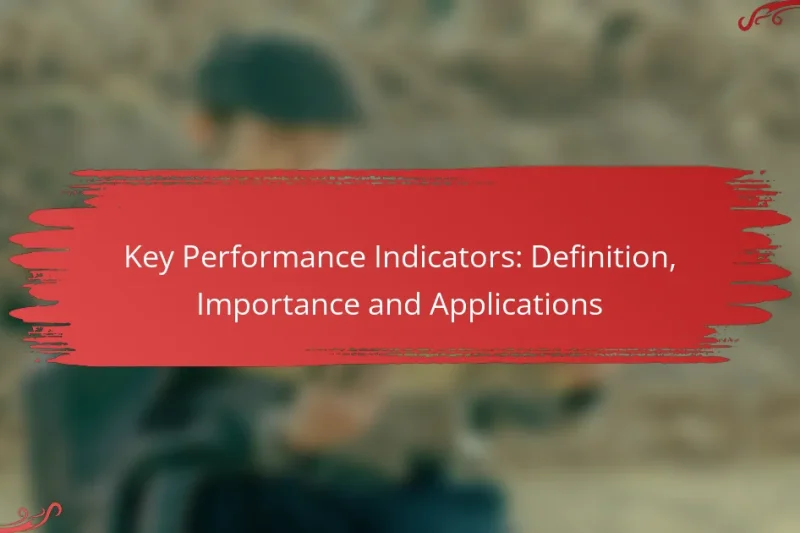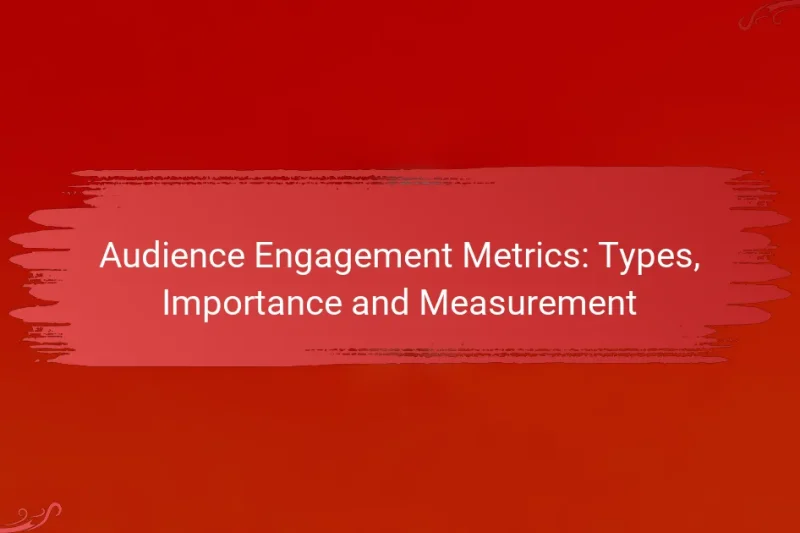Ethical reporting is grounded in key principles such as accuracy, transparency, respect for privacy, and accountability, … Ethical Reporting: Principles, Methods and AccountabilityRead more
The media industry is undergoing significant transformation driven by advancements in research and analytics. Key trends such as the integration of AI, audience segmentation, and real-time data analysis are enabling companies to better understand their audiences and refine their content strategies. By leveraging data-driven insights, media organizations can enhance advertising effectiveness and improve overall engagement, ultimately leading to increased revenue.
Traditional vs Digital Media Metrics: Which Is Better and When to Use
In the evolving landscape of marketing, understanding the differences between traditional and digital media metrics is … Traditional vs Digital Media Metrics: Which Is Better and When to UseRead more
Key Performance Indicators: Definition, Importance and Applications
Key Performance Indicators (KPIs) are essential tools for measuring the effectiveness of display advertising campaigns. By … Key Performance Indicators: Definition, Importance and ApplicationsRead more
Audience Engagement Metrics: Types, Importance and Measurement
Understanding audience engagement metrics is essential for evaluating how users interact with your content. By measuring … Audience Engagement Metrics: Types, Importance and MeasurementRead more
Media Metrics: Selection Criteria, Alignment with Goals and Impact
In the realm of display advertising, selecting the right media metrics is crucial for evaluating campaign … Media Metrics: Selection Criteria, Alignment with Goals and ImpactRead more
Bias in Media Research: Identification, Impact and Mitigation
Bias in media research poses significant challenges to the integrity and reliability of findings, often distorting … Bias in Media Research: Identification, Impact and MitigationRead more
Compliance Regulations: Key Frameworks and Requirements
Compliance regulations play a crucial role in safeguarding sensitive information and ensuring privacy across various sectors. … Compliance Regulations: Key Frameworks and RequirementsRead more
Media Reports: Tailoring for Audience Segments and Engagement
Media reports have the potential to engage diverse audience segments by customizing content to align with … Media Reports: Tailoring for Audience Segments and EngagementRead more
Surveys: Design, Implementation and Analysis
Surveys are powerful tools for gathering insights when designed with clear objectives and structured questions. Effective … Surveys: Design, Implementation and AnalysisRead more
Media Insights Dashboards: Tools, Techniques and Visualization
Media insights dashboards are essential tools for organizations looking to analyze media performance and track key … Media Insights Dashboards: Tools, Techniques and VisualizationRead more
What are the key trends in media industry research and analytics?
Key trends in media industry research and analytics include the growing integration of AI and machine learning, a strong focus on audience segmentation, and an increasing emphasis on real-time data analysis. These trends are shaping how media companies understand their audiences and optimize their content strategies.
Increased use of AI and machine learning
The media industry is increasingly leveraging AI and machine learning to enhance research and analytics capabilities. These technologies enable companies to analyze vast amounts of data quickly, identify patterns, and predict audience behavior more accurately.
For example, AI algorithms can process viewer preferences and engagement metrics to recommend personalized content, improving user satisfaction and retention. Companies should consider investing in AI tools that align with their specific analytics needs to maximize effectiveness.
Focus on audience segmentation
Audience segmentation has become a critical focus for media companies aiming to tailor their content and marketing strategies. By dividing audiences into distinct groups based on demographics, interests, and behaviors, companies can create more targeted and relevant experiences.
Effective segmentation allows for personalized advertising and content delivery, which can significantly boost engagement rates. Media organizations should regularly update their segmentation strategies based on evolving audience data to remain competitive.
Emphasis on real-time data analysis
Real-time data analysis is essential for media companies to respond swiftly to audience trends and preferences. This approach allows organizations to make informed decisions based on current data rather than relying on outdated reports.
Utilizing real-time analytics tools can help companies track viewership patterns, social media interactions, and content performance as they happen. Implementing these tools can lead to more agile content strategies and improved audience engagement.
How can media companies leverage analytics for advertising?
Media companies can leverage analytics for advertising by utilizing data-driven insights to enhance targeting, measure performance, and optimize campaigns. This approach allows for more effective ad placements, improved audience engagement, and ultimately, increased revenue.
Targeted advertising strategies
Targeted advertising strategies involve using analytics to identify specific audience segments based on demographics, interests, and behaviors. By analyzing data from various sources, such as social media and website interactions, companies can create tailored messages that resonate with distinct groups.
For instance, a media company might use viewer data to target ads for a new drama series specifically to users who have previously engaged with similar content. This precision can lead to higher conversion rates and better return on investment (ROI).
Performance measurement and optimization
Performance measurement and optimization are critical for assessing the effectiveness of advertising campaigns. Media companies should track key performance indicators (KPIs) such as click-through rates, conversion rates, and engagement metrics to determine what works and what doesn’t.
Regularly analyzing these metrics allows companies to make data-informed adjustments to their campaigns. For example, if a particular ad format is underperforming, they can experiment with different creatives or placements to enhance results. Utilizing A/B testing can also provide insights into which variations yield better outcomes.
What tools are essential for media analytics?
Essential tools for media analytics include platforms that provide insights into audience behavior, content performance, and data visualization. These tools help media professionals make informed decisions based on quantitative data and trends.
Google Analytics for media insights
Google Analytics is a powerful tool for tracking website traffic and user engagement. It offers detailed reports on user demographics, behavior, and acquisition channels, allowing media companies to understand their audience better.
To maximize its effectiveness, set up goals and conversion tracking to measure specific actions, such as video views or article shares. Regularly review your analytics dashboard to identify trends and adjust your content strategy accordingly.
Tableau for data visualization
Tableau is a leading data visualization tool that helps media organizations turn complex data sets into interactive, easy-to-understand visual formats. It allows users to create dashboards that can showcase key performance indicators (KPIs) and trends at a glance.
When using Tableau, focus on clarity and simplicity in your visualizations. Avoid clutter by limiting the number of metrics displayed at once and using color effectively to highlight important data points.
Adobe Analytics for audience tracking
Adobe Analytics provides robust audience tracking capabilities, enabling media companies to analyze user interactions across various platforms. It offers insights into customer journeys, helping organizations tailor their content and marketing strategies.
Utilize segmentation features to target specific audience groups and measure the effectiveness of campaigns. Regularly update your tracking parameters to ensure you capture relevant data as user behavior evolves.
What are the challenges in media analytics?
Media analytics faces several significant challenges, including data privacy regulations and the integration of disparate data sources. These obstacles can hinder effective analysis and decision-making in the media industry.
Data privacy regulations
Data privacy regulations, such as the General Data Protection Regulation (GDPR) in Europe and the California Consumer Privacy Act (CCPA) in the United States, impose strict guidelines on how personal data can be collected and used. Compliance with these laws is crucial for media companies to avoid hefty fines and maintain consumer trust.
Organizations must implement robust data governance frameworks to ensure that they handle user data responsibly. This includes obtaining explicit consent from users, anonymizing data where possible, and being transparent about data usage.
Integration of disparate data sources
Integrating disparate data sources is a common challenge in media analytics, as data may come from various platforms such as social media, streaming services, and traditional broadcasting. Each source may have different formats, metrics, and reporting standards, complicating the analysis process.
To overcome this challenge, media companies should invest in data integration tools that can harmonize data from multiple sources. Establishing a centralized data repository can facilitate easier access and analysis, allowing for more comprehensive insights into audience behavior and content performance.
How does audience behavior impact media strategies?
Audience behavior significantly influences media strategies by dictating content creation, distribution methods, and marketing approaches. Understanding how audiences engage with different media formats allows companies to tailor their strategies for maximum impact and relevance.
Shifts in content consumption patterns
Content consumption patterns have evolved dramatically, with audiences increasingly favoring on-demand and mobile-friendly formats. Streaming services, podcasts, and short-form videos are now preferred over traditional television and print media. Media companies must adapt by producing content that aligns with these preferences, such as creating binge-worthy series or engaging social media clips.
To stay competitive, organizations should regularly analyze viewership data and audience feedback to identify emerging trends. For example, a rise in mobile viewing may prompt a shift towards shorter, more engaging content that fits into users' busy lifestyles.
Influence of social media trends
Social media trends play a crucial role in shaping audience behavior and, consequently, media strategies. Platforms like Instagram, TikTok, and Twitter not only serve as distribution channels but also influence what content becomes popular. Media companies need to monitor these trends closely to leverage viral content and engage with audiences effectively.
Incorporating user-generated content and collaborating with influencers can enhance authenticity and reach. For instance, brands might encourage audiences to share their experiences with a product or service on social media, creating a community-driven marketing approach that resonates with potential customers.
What are the best practices for media research?
Best practices for media research involve systematic methods to gather and analyze data about audiences and content performance. These practices ensure that insights are reliable and actionable, guiding strategic decisions in the media industry.
Regular audience surveys
Conducting regular audience surveys is essential for understanding viewer preferences and behaviors. Surveys can be distributed online or through direct outreach, allowing for a broad range of feedback on content, formats, and platforms.
To maximize effectiveness, tailor questions to specific goals, such as gauging satisfaction or identifying content gaps. Aim for a response rate of at least 10-15% to ensure a representative sample, and consider incentivizing participation with small rewards.
Utilizing A/B testing
A/B testing is a powerful method for comparing two versions of content to determine which performs better. By randomly assigning segments of your audience to different versions, you can measure engagement metrics like click-through rates or viewing time.
When implementing A/B tests, keep changes minimal to isolate the impact of specific elements, such as headlines or images. Run tests for a sufficient duration, typically a week or more, to gather reliable data. Avoid common pitfalls like testing too many variables at once, which can complicate results.
How to choose the right analytics platform?
Choosing the right analytics platform involves assessing your specific needs, budget, and the features offered by various tools. Focus on platforms that provide robust data visualization, integration capabilities, and user-friendly interfaces to ensure effective analysis of media performance.
Identify your goals and requirements
Start by defining what you want to achieve with your analytics platform. Are you looking to track audience engagement, measure ad performance, or analyze content effectiveness? Understanding your objectives will help narrow down your options.
Consider the types of data you need to analyze, such as social media metrics, website traffic, or sales conversions. This will guide you in selecting a platform that specializes in those areas.
Evaluate features and integrations
Look for platforms that offer essential features like real-time analytics, customizable dashboards, and automated reporting. These capabilities can significantly enhance your ability to make data-driven decisions.
Check if the platform integrates with other tools you already use, such as CRM systems or content management systems. Seamless integration can streamline your workflow and improve data accuracy.
Consider your budget
Analytics platforms vary widely in cost, from free tools with basic features to premium solutions that can run into thousands of dollars per month. Establish a budget that aligns with your organization's financial resources and expected return on investment.
Keep in mind that some platforms offer tiered pricing based on features or user limits. Evaluate whether the investment will provide sufficient value based on your analytics needs.
Test and compare options
Before making a final decision, take advantage of free trials or demos offered by analytics platforms. This hands-on experience can help you assess usability and functionality.
Compare multiple platforms based on your predefined criteria, such as ease of use, support services, and scalability. Gathering feedback from team members who will use the platform can also provide valuable insights.














